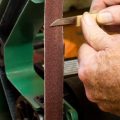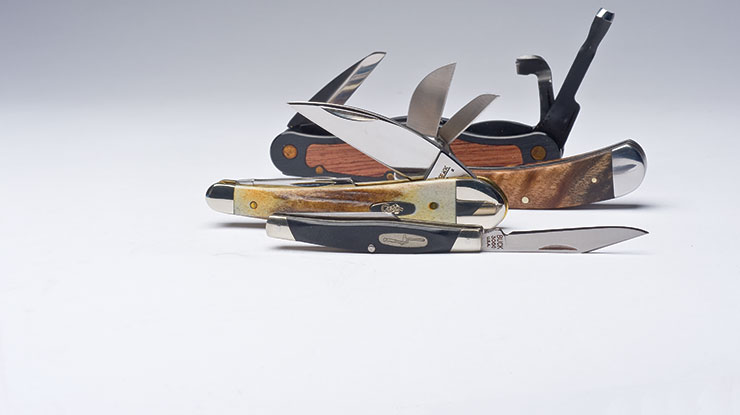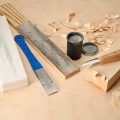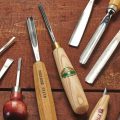Make smart purchases with a basic understanding of the cutters available
by Chuck Solomon and Dave Hamilton
Photos of bits in use courtesy of Foredom
This article was first published in issue 48 of Woodcarving Illustrated.
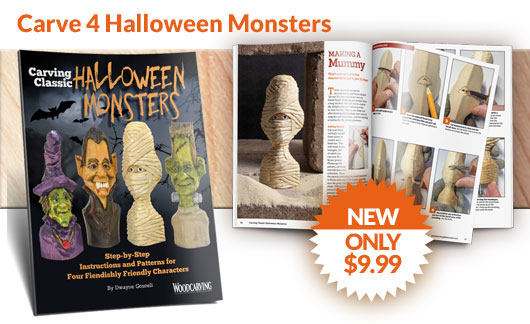
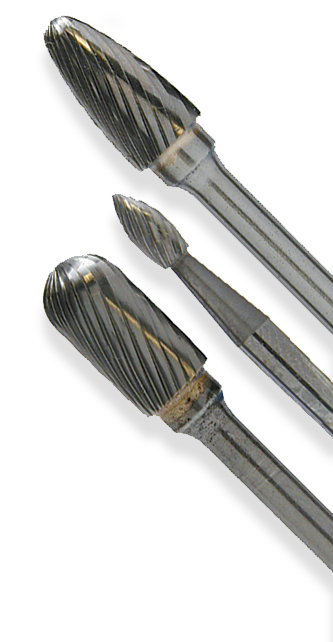
In power carving, the bur or bit is the part of the tool that does that actual wood removal. The power carving tool, such as a flexible shaft machine or micro motor, spins the bit at a high speed and the cutting surface or abrasive on the bit removes the wood. Power carving bits go by names such as burs, cutters, carvers, stones, and discs.
Bits are manufactured from a variety of materials and are available in many shapes, head sizes, and shank sizes. The sheer volume of bits available can be overwhelming. By breaking down the categories and taking a look at the performance of the different types of bits, you can choose the best bit for the job.
Shank Diameter
The shank is the backbone of the bit. One end of the shank is inserted in the rotary power carver. The head of the bit is formed around the opposite end of the shank. The most common shank diameters are ¼”, 1/8″, 3/32″, and 1/16″. Flexible shaft machines accept any of these diameters when equipped with the appropriate collet. Micro motors typically accept 1/8″- and 3/32″-diameter shanks, although, optional collets can be purchased for alternate size shanks. Air turbine machines use only friction bits with a 1/16″-diameter shank. Generally, the larger the size of the bit’s head, the larger the diameter of the shank. Use the largest bit you comfortably can for the area you are carving. When inserting the bit into your rotary power carver, make sure the shank is as far into the tool as it will go.
Head Shape and Size
Bits are grouped into a few general shapes. The shape of the bit’s head determines the contour of the cut. The larger the head, the more wood it will remove. Larger bits are generally used for roughing out a piece and smaller bits are used to add details.
Many of the shapes have very specific purposes, but we tend to use the ball, cylinder, flame, and pear-shaped bits the most.
 |
Bull nose/ball nose:
- Combines a ball with a cylinder
- Use to make concave cuts and hollow out areas using the top
- Use the side to cut flat areas and round edges
- Creates a cut similar to a U-gouge with the top and a knife cut with the side
|
 |
Cylinder:
- Use to cut flat areas, round edges, and make stop cuts and V-cuts
- Creates a cut similar to a knife or straight chisel
- Hold the tool at an angle and use the top corner to make V-cuts
- Smooth-end or safe-end bits are the most useful
|
 |
Flame:
- Use to make concave cuts and V-cuts, and to recess areas
- Creates a cut similar to a U-gouge when using its side and a V-tool when using the tip
|
 |
Large taper:
- Use to round edges, make concave cuts, and access hard-to-reach areas
|
 |
Small Taper:
- Use to access hard-to-reach and angled areas
- Create feather barbules and hair
|
 |
Oval:
- Use to round edges, create lumps and bumps, and make concave cuts
|
 |
Ball:
- Use to create concave cuts and to hollow out areas
- Creates a cut similar to a U-gouge
|
 |
Inverted Cone:
- Use to make V-cuts for feather barbules and hair
|
 |
Disc:
- Use to undercut feathers and make channel cuts
- Cut off thin pieces of unwanted wood
|
|
 |
Pear:
- Use to round edges and create lumps and bumps when bird carving
|
|
Grits and Materials
Bits are made from a variety of materials. These materials vary greatly in cost, cutting speed, durability, and the smoothness of the surface they leave behind. The most coarse and longlasting bits feature aggressive carbide points bonded to a metal shaft. These bits remove wood fast, but leave a rough surface. The finest cutting bits are man-made stones which produce a smooth surface. Coarse bits work best at slower rpm and finer bits work best at higher rpm.
|
Carbide-point Bits
Brand names:
Typhoon, Saburr Tooth, Kutzall
Average price per bit: $15 to $20
Shank diameters:¼”, 1/8″, 3/32″
Durability:High: we have several bits we have used for more than ten years without a noticeable change in their ability to remove wood
- Most aggressive bits available
- Used for rapid stock removal when roughing out both hard and soft wood
- Produce a relatively rough surface
- Typhoon, Saburr Tooth, and Kutzall Extreme make cleaner cuts, collect less debris, and are easier to clean because the points are structurally aligned
- Kutzall bits cut fast, but leave a rougher surface and can be difficult to clean
- Cut wood, acrylic, plaster, and fiberglass
|
Carbide Cutters
Brand names:
Various
Average price per bit: $12 to $20
Shank diameters: ¼”, 1/8″, 3/32″, 1/16″
Durability: High: long-lasting bits are nearly as durable as carbide-point bits
- Produce a relatively smooth surface on woods
- Available in fluted and cross-cut styles
- Large bits with ¼”-diameter shafts useful for roughing out carvings
- Smaller bits can be used to add detail to carvings
- Cut wood, acrylic, plaster, and fiberglass
|
|
Carbide-grit Bits
Brand names:
Dura-Grit
Average price per bit: $15
Shank diameters: 1/8″
Durability: High: tough carbide grit stays sharp and won’t tear loose, but wears out faster than carbide cutters and carbide-point bits
- Available in several grits
- Available in most shapes including cutting wheels
- Cut wood, laminates, fiberglass, gourds, and ceramics
|
Mini Saw & Carving Drills
Brand names:
Various
Average price per bit: $10
Shank diameters: 1/8″, 3/32″
Durability: High: Mini saw drills are made from high-speed steel coated with titanium nitride; carving drills are made from high-tempered steel. Both types of drills have great heat resistance and life
- Used to drill holes and carve out from the holes on pierced turnings and relief carvings
- Difficult to control on an in-the-round carving
- Cut wood up to ¾” thick.
- Come in a variety of sizes
|
|
High-speed Steel Bits
Brand names:
Various
Average price per bit: $11
Shank diameters: 1/8″, 3/32″
Durability: Medium: longlasting, but not as durable as carbide bits
- Available in more shapes than carbide bits
- Useful for cutting grooves and countersinking
- Less expensive, but less durable than carbide, diamond, or ruby bits
- Cut wood, bone, antler, plastic, and soft metals
|
Stump Cutters
Brand names:
Various
Average price per bit: $9 to $11
Shank diameters: 3/32″
Durability: Medium: vanadium steel cutters last longer than high-speed steel bits, but not as long as diamond or ruby bits
- Serrated edges remove wood quickly, but leave a smooth surface
- Cut most woods, bits wear out faster when carving hard dense woods
|
|
Diamond Bits
Brand names:
Various
Average price per bit: Plated: $7 to $10,
Sintered: $20 to $25
Shank diameters: ¼”, 1/8″, 3/32″, 1/16″
Durability: High: sintered diamond bits are almost as durable as carbide bits; plated diamond bits are less durable than sintered diamond bits
- Plated diamond bits feature a single layer of diamond particles embedded in the shaped metal head
- Sintered diamond bits feature diamond particles bonded with powdered bronze matrix, which are then bonded to the metal head
- Sintered diamond bits can be sharpened and reshaped slightly with a diamond dressing stone
- Plated diamond bits cannot be reshaped
- Used to texture and carve fine details
- Available in several grits
- Available in more shapes than any other bit
- Used for final shaping, texturing, and detailing
- Cut wood, hardened steel, glass, ceramic, bone, antler, stone, and precious metals
|
Ruby Bits
Brand names:
Various
Average price per bit: $9
Shank diameters: 1/8″, 3/32″
Durability: Medium: last longer than stones, but are less durable than diamond bits
- Particles of ruby bonded to a metal frame
- Remove wood quickly, but leave a smooth finish
- Available in fine, medium, and coarse grits
- Cut steel, ceramic, wood, soft and precious metals, bone, and antler
|
|
V Stones
Brand names:
Foredom
Average price per bit: $3 to $5
Shank diameters: 1/8″, 3/32″
Durability: Medium: last longer than ordinary aluminum-oxide stones, but less than ruby bits
- Made from a vitrified self-sharpening aluminum-oxide grain
- Cool-running and long-lasting abrasive stones
- Cut wood, metals, acrylic, glass, and marble
|
CeramCut Blue Stones
Brand names:
Foredom
Average price per bit: $2 to $3
Shank diameters: 1/8″, 3/32″
Durability: Medium: last longer than other stones, but less than ruby bits
- Made from ceramic and aluminum-oxide for strength and cutting speed
- Run cooler than other stones, which makes them less likely to burn wood
- Leave a smooth finish
- Cut wood, mild steel, steel alloys, and ferrous metals
|
|
Aluminum-oxide Stones
Brand names:
Various
Average price per bit: $1.50 to $2.50
Shank diameters: 1/8″, 3/32″
Durability: Low: least durable bit
- Available in various grits
- Red (coarse, 80 to 150 grit) and white (fine, 400 grit) are mostly used for wood
- Red used for fast wood removal
- White used for fine texturing, such as bird feathers or mammal fur
- Stones can be reshaped and sharpened easily to extend their life.
- Cut wood, mild steel, and soft metals
|
Silicon-carbide Stones
Brand names:
Various
Average price per bit: $2 to $3
Shank diameters: 1/8″, 3/32″
Durability: Low: last longer than aluminum-oxide stones, but are less durable than CeramCut Blue Stones
- Silicon-carbide mixture bonded to a stainless steel head and shank
- More aggressive than white stones but less aggressive than red stones
- Used to create lumps and bumps on bird carvings, with a limited ability to create feathers and hair
- Cut wood, aluminum, brass, glass, and gemstones
|
|
Ceramic Texturing Rods
Brand names:
Various
Average price per bit: $22
Shank diameters: 1/8″, 3/32″
Durability: Medium: last longer than white stones, but are less durable than diamond bits
- Used to create feather barbules, fur, or hair
- Available in three grits: 300, 800, and 1200
- Entire 2″-long rod can be dressed or shaped for texturing, giving the rods longer life
- Cut them in half and dress the four ends with different shapes and sizes
- Our top choice for creating fine detail for feathers and hair
|
Sanding Bands & Discs
Brand names:
Dremel, Foredom, 3M Cubitron
Average price per bit: drum: $3, sanding bands: $0.50 to $0.75
Shank diameters: ¼”, 1/8″, 3/32″
Durability: Medium to low: ordinary aluminum-oxide sanding bands last as long as ordinary sandpaper, 3M Cubitron ceramic aluminum-oxide bands last at least twice as long
- Require a reusable mandrel or rubber drum
- Available in many grits
- Drums available in many sizes
- Cartridge and tapered rolls available for split mandrels in various sizes and grits
|
|
Cushioned Sanding Drums
Brand names:
Various
Average price per bit: $16 to $17
Shank diameters: ¼”, 1/8″
Durability: Low: the drums are very durable, the sandpaper cover lasts as long as ordinary sandpaper
- Mandrel with soft rubber backing and a slot for the sandpaper to be wrapped around the rubber backing
- Work best with cloth-backed sandpaper
- Includes a metal template which allows you to cut any grit of sandpaper to size
- One of our most-used tools
|
Defuzzing Pads & Radial Bristle Brushes
Brand names:
3M, Scotchbrite
Average price per bit: $0.80 per 6″ x 9″ sheet: $1.50 per bristle brush
Shank diameters: 1/8″, 3/32″
Durability: Low: synthetic steel wool pads and synthetic or horse hair bristles wear out quickly
- Pads require a mandrel, clamp one or two squares on the mandrel
- Pads used to remove fuzz before texture is carved
- Brushes used to remove wood fuzz and clean area between barbules and hair before painting
- Create your own pads by cutting 1½” to 2″ squares of synthetic steel wool
|
|
Radial Bristle Discs
Brand names:
3M, Scotchbrite
Average price per bit: $1.25 per individual disc
Shank diameters: 1/8″, 3/32″
Durability: Medium: last as long as 3M ceramic aluminum-oxide sandpaper
- Require a mandrel, usually stack in groups of three to six on the mandrel
- 3M Cubitron ceramic and aluminum-oxide particles are embedded in the bristles
- Disc diameters range from ¼” to 3″
- Disc grits range from 80 grit to 1 micron (14,000 grit)
- Use slower speeds for control, faster speeds for aggressive wood removal
- Useful for defuzzing
- Cut wood, precious and soft metals, and ceramic
|
|

Maintenance
Over time, you will accumulate a number of bits to meet your carving needs. It makes sense to keep the bits sharp and in good condition in order to protect your investment. We recommend the following tips to prolong the life of your bits:
- Store your bits in a holder of some sort to prevent them from banging into each other.
- Don’t apply so much pressure that you burn your bits.
- Clean your carbide-point bits with a brass brush.
- Remove stubborn sawdust with oven cleaner.
- Use a wet white whetstick to clean diamond bits.
- Use a neoprene rubber bar to remove dust from ruby bits, stones, sanding discs, sanding drums, and cushioned sanding drums.
- Reshape and clean stones with a diamond hone or dressing stone.
Every carver has his or her own favorite bits. Experiment with bits of different sizes and materials to get a good feel for their capabilities. When selecting a bit for a specific purpose, power carver Jack Kochan asks himself the following questions to help determine which bit to choose:
- How fast do I want to remove wood?
- How much wood do I want to remove?
- How smooth do I want the wood to be when I finish this section?
- What size bit is best suited for the area I want to carve?
Recommended Starter Set
We recommend the following bits as an initial investment: |
 A defuzzing pad and soft bristle brush
|
 Small carbide point bits, from left: fine cylinder, coarse flame, coarse ball, fine ball
|
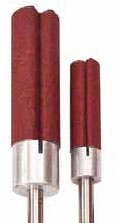 Two cushioned sanding drums (large and small) with assorted grits of sandpaper
|
 Regular-grit diamond or ruby bits from left: pear, safe-end tapered, medium flame, small flame, small tapered
|

Texturing bits from left: small taper green stone, small ball green stone, small tapered stone with a rounded tip, blue ceramic rod
|
| In addition to the bits above, choose carbide-point bits with ¼”-diameter shafts for roughing out. |
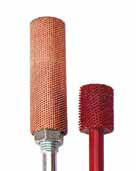 Smaller carvings require smaller and fewer carbide-point bits, from left: fine cylinder sleeve, coarse cylinder
|
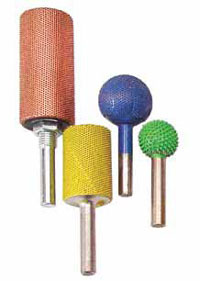 For large carvings, use large carbide-point bits, from left: fine cylinder sleeve, fine cylinder, fine ball, coarse ball
|
|
CLICK HERE to download a PDF of this article.
About the Authors
Chuck Solomon (left) and Dave Hamilton are avid carvers and instructors. They have co-authored The Art of Stylized Wood Carving, Carving Hummingbirds, and Carving North American Hummingbirds, all available at www.foxchapelpublishing.com.
Discuss this material on the Woodcarving Illustrated forums.
Read more about tools for beginners!





































